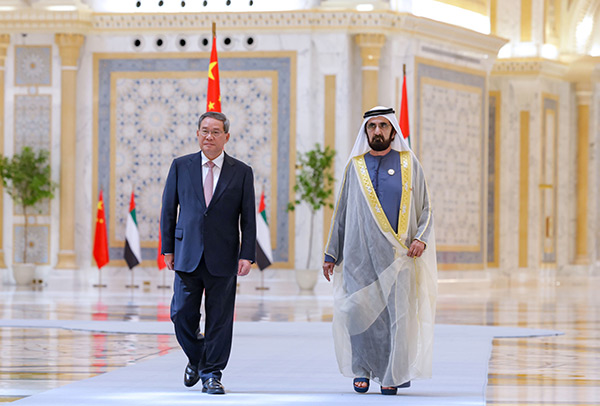Chinese Premier Li Qiang’s recent visits to Saudi Arabia and the UAE have marked a significant step towards strengthening economic cooperation with two of the Gulf region’s wealthiest nations. The visits focused on expanding collaboration in traditional sectors like oil and gas, while forging new ties in critical emerging industries, including new energy, electric vehicles (EVs), and digital economy initiatives.
The deepening of ties with these Gulf countries is part of China’s broader strategy to cement its influence in the Middle East, a region undergoing a transformative shift toward economic diversification and sustainable development. Premier Li’s emphasis on new energy partnerships aligns with the Gulf Cooperation Council (GCC) nations’ ambitions to reduce dependence on fossil fuels and invest in renewable energy.
Strengthening the new energy partnership
During his 4-day trip, Li met with UAE President Sheikh Mohamed bin Zayed Al Nahyan and Saudi Crown Prince Mohammed bin Salman, pledging to enhance cooperation in several high-growth sectors.
Of particular importance is the burgeoning field of new energy, which Li and the Gulf leaders agreed is “crucial” to the future of the Middle Eastern economy. As these nations work toward long-term energy transition goals, China’s expertise in green technologies and renewable energy will play a key role.
China, a global leader in solar power and EV production, is well-positioned to support the UAE and Saudi Arabia in their renewable energy pursuits. The UAE, already home to the world’s largest single-site solar power plant – a flagship project under Beijing’s Belt and Road Initiative (BRI) – is expected to be a major partner in China’s push to export its green technologies to the Middle East.
The EV sector also stands to benefit from this collaboration. Leading Chinese EV manufacturers like BYD and Nio have already entered the UAE market, capitalizing on the country’s infrastructure and growing demand for sustainable transportation solutions. This is expected to further enhance China’s dominance in the global EV market while offering the UAE valuable expertise in reducing its carbon footprint.
Expanding trade and investment horizons
Beyond energy, Premier Li’s trip highlighted the growing trade ties between China and the Gulf nations. Bilateral trade between China and the UAE reached a record-breaking US$50 billion in the first half of 2024, showcasing the strength of economic cooperation. Meanwhile, Chinese investments in the UAE surged by over 16 percent to US$1.3 billion last year, and the UAE reciprocated with investments in China growing by 120 percent.
In fact, the UAE’s investments accounted for 90 percent of all Arab investment into China in 2023 while China’s investments in the UAE represented 60 percent of China’s total investment in Arab countries.
In Saudi Arabia, Li emphasized collaboration in petrochemicals and infrastructure construction but also called for expanding cooperation in the digital economy and green technologies. These areas are aligned with Saudi Arabia’s Vision 2030, an ambitious plan to diversify the kingdom’s economy beyond oil.
Free trade agreement with GCC
Li’s trip also revived discussions around the long-awaited China-GCC free trade agreement. The agreement, which has been in talks for years, is seen as a critical component of China’s broader Middle Eastern strategy. According to Wen Shaobiao, a Middle East affairs specialist, the free trade deal would not only facilitate deeper economic ties but also serve as a cornerstone project for China’s Belt and Road Initiative in the region.
Both China and the GCC nations are keen on concluding the agreement to drive mutual economic benefits. For the Gulf countries, this is an opportunity to attract more Chinese investment into emerging sectors such as green energy and high-tech manufacturing. For China, it offers a chance to further solidify its presence in the Middle East, a region of strategic importance for trade and energy security.
In the Middle East, the UAE is China’s second-largest trading partner, the largest export market, and the third-largest market for Chinese engineering projects.
Treading a path to achieve mutual growth
Premier Li’s visits to Saudi Arabia and the UAE underscore the mutual commitment to enhancing cooperation in both traditional and emerging sectors. With both countries looking to diversify their economies, the collaboration between China and the Gulf states presents a promising opportunity to jointly build new growth points in industries like new energy, digital economy, and high-end manufacturing.
As China continues to strengthen its Belt and Road projects in the region, businesses from both nations are encouraged to seize the moment and capitalize on these new opportunities. The integration of the Gulf countries into global supply chains through partnerships with China is expected to unlock substantial economic benefits, creating a foundation for sustainable and diversified growth in the Middle East.
The future of China-Gulf relations looks bright, as deeper economic collaboration paves the way for long-term prosperity. By aligning development strategies, the two regions are well-positioned to take advantage of the new opportunities offered by their shared vision for a greener, more sustainable future.



